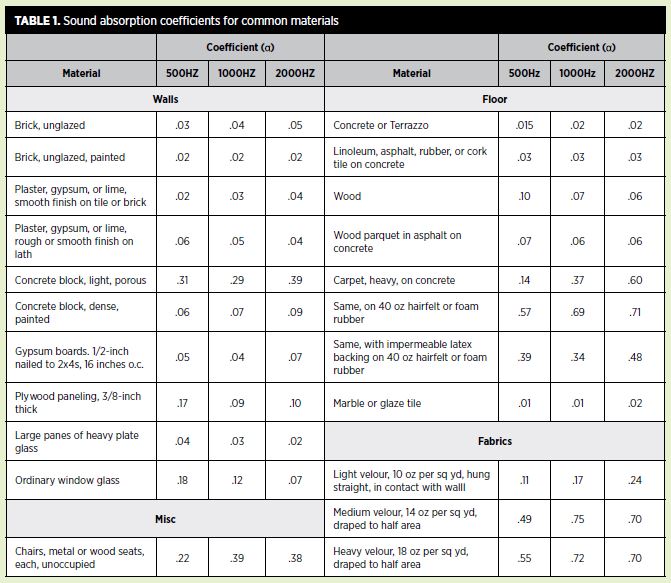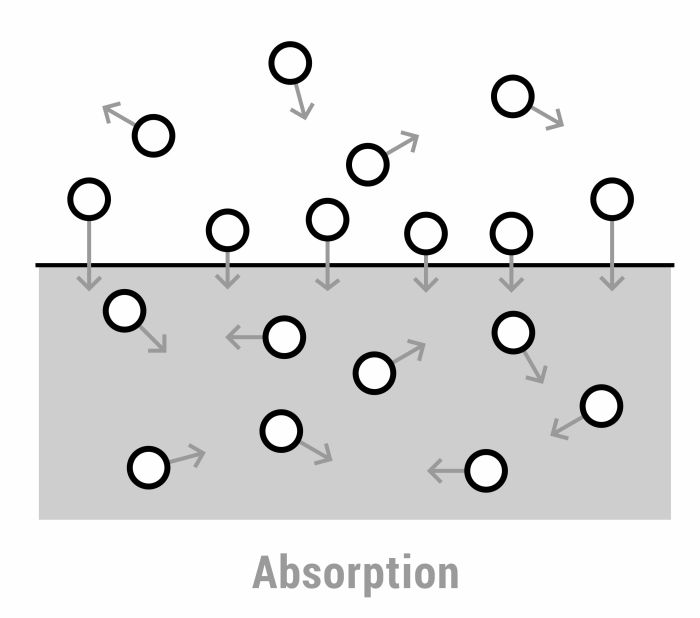Below you will find a list of commonly-accepted Absorption Coefficients that we use to measure how “absorptive” each surface is when calculating reverberation time. Absorption coefficients are an average of how absorptive each product is at numerous frequencies, often-times specifically at 500 Hz, 1000 Hz, and 2000 Hz. Generally speaking, soft, porous materials will be more absorptive than hard, reflective surfaces.
For instance, marble flooring is extremely dense and hard, making it very difficult for sound to find openings in which the air molecules can become trapped and turned into heat. Likewise, concrete, drywall, metal, and glass are all reflective surfaces. However, carpeting, soft furniture (not wood or leather), and draperies are all common absorptive surfaces. NRC is simply the measure of “how absorptive a surface is”. Acoustic panels have an Absorption Coefficient of 1.0, meaning that they do not reflect any of the energy that contacts them.
Remember that when sound impacts a target, it can do one of three things: reflect, absorb, or transmit through. Absorption coefficients can be misleading in that sense, because a very thin sheet of fabric may have an NRC of 1.0, while a plush, velvet curtain may also have an NRC of 1.0. Both of these materials reflect approximately 0% of the incoming sound energy. However, the thin fabric may transmit 90% of the energy and absorb 10%, while the plush curtain may transmit 50% of the sound energy and absorb 50%.
See How Much Absorption You Need with our Acoustic Calculator
Determine Target Reverberation Times
List of Absorption Coefficients by Finish Type
| Multi-Surface Acoustical Coefficient | |
| Smooth Concrete – Unpainted | 0.2 |
| Smooth Concrete – Painted | 0.05 |
| Wood | 0.15 |
| Rubber | 0.05 |
| Plywood | 0.25 |
| Walls – Acoustical Coefficient | |
| CMU – Unpainted | 0.35 |
| CMU – Painted | 0.05 |
| Brick – Unpainted | 0.05 |
| Brick – Painted | 0.025 |
| Steel – Structural | 0.1 |
| Plaster | 0.05 |
| Gypsum | 0.1 |
| Glass | 0.05 |
| Flooring – Acoustical Coefficient | |
| Linoleum | 0.05 |
| Terrazo | 0 |
| Marble | 0 |
| Carpet on Foam Rubber | 0.55 |
| Carpet on Padding | 0.3 |
| Low Carpet | 0.2 |
| Hardwood | 0.3 |
| Acoustic Treatments – Acoustical Coefficients | |
| Cellulose Fibers (1″) | 0.75 |
| Polyurethane Foam | 0.3 |
| Semi Rigid Fiberglass (1″) | 0.75 |
| Cork Tiles | 0.7 |
| Acoustic Ceiling Tiles | 0.5 |
Table of Common Acoustical Absorption Coefficients
Remember that there is a range of NRC for many of these products. For instance, Acoustic Ceiling Tiles can range from a 0.45 absorption coefficient to 0.85 for some of Armstrong’s higher-end acoustic tiles. Similarly, carpets range in thickness and plushness, which will greatly affect how much sound is absorbed by them.
There are a range of other specialty acoustic treatments as well, such as the stretched fabric wall system. This performs in much the same way as acoustical panels, using breathable, acoustically-rated fabric stretched over dense fiberglass to provide a high-performance acoustic treatment. This type of system is preferred when panels are needed floor-to-ceiling or when there are penetrations through the fabric wall.
Also, remember that NRC alone is an approximation of the amount of sound that is absorbed. For special applications, additional attention should be paid to low-frequencies, such as 125 Hz and 250 Hz frequency bands. For a detailed breakdown of frequency specific performance, look at LEED v4, used to assign acoustic points for LEED-certified buildings if certain speech privacy and comfort criteria are met.

What is the Difference Between NRC (Noise Reduction Coefficient) and Sound Absorption Coefficient?
These two ratings are closely related. However, NRC can be thought of as an “average” of the Sound Absorption Coefficients of a material. For instance, an acoustic wall panel may have an absorption coefficient of 0.5 at 500 Hz, 0.9 at 1000 Hz, and 1.0 at 2000 Hz. As is often the case, material tend to have higher absorption ratings at higher frequencies (where wavelength is reduced). The NRC rating of the acoustic panel may be 0.85, which is an average of each of those individual sound absorption coefficients.
Thus, NRC provides a simplified, single-number approximation of the sound absorption rating at individual frequencies.
In conclusion, Absorption Coefficients are a critical variable of the overall acoustic treatment approach. By measuring the space and determining the proper coefficients and treatment area, unwanted reverberation may be accounted for prior to construction. If echo is already an issue in the space, using material with sufficient acoustic absorption will greatly reduce reverberation and corresponding noise issues.



